Is Bill 38 enough to disrupt economic migration barriers?
by Cicely Belle Blain
I recently attended an event in Burnaby that introduced several new provincial and local strategies to address the “gaps between employers and job-seekers.” One such strategy is Premier David Eby and Workforce Development Minister Andrew Mercier’s new provincial bill (Bill 38) that promises easier employment for newcomers to the province.
While the event was marketed to both business owners/employers and job-seekers, the crowd was largely the former. Mercier spoke at the event, and the discussion predictably skewed towards the age-old myth that ‘nobody wants to work anymore.’ Employers shared frustrations around finding workers who are ‘skilled’ and ‘hard-working’ while the other side of the story was notably under-represented.
Mercier’s initiatives promise to reduce professional barriers faced by immigrants and refugees when they arrive in British Columbia, but is it enough?
There has been a long history of discriminatory labour migration practices in Canada. As Harsha Walia explores in her book Undoing Border Imperialism, borders are tools of oppression that reinforce systemic injustices and serve the interests of dominant powers. As such, borders perpetuate exclusionary practices in the realm of labour migration, contributing to the marginalization and exploitation of vulnerable groups while safeguarding the economic advantages of those in power.
A literature review by Dr. Nalinie Mooten underscores the unsettling parallels between current exploitation and past forms of servitude. The indentured labour system, historically used to control and exploit workers, finds echoes in the modern-day conditions where workers are bound to specific employers, fostering an environment of fear and compliance.
The other event-goers believe there are not enough ‘skilled’ workers while failing to recognize that Mercier and his political peers have not yet provided the accessibility, safety, protection or perhaps even appeal necessary for this issue to be resolved.
All labour requires skills, but this constructed hierarchy creates further barriers and disparities.
The issue is nestled in this expectation: Canada and many other countries create a dichotomy of ‘skilled’ and ‘unskilled’ labour. All labour requires skills, but this constructed hierarchy creates further barriers and disparities.
For example, foreign doctors aiming to practice in British Columbia must have their credentials recognized, demonstrate English proficiency, obtain a medical license, and follow specific pathways for specialization. They must also go through the Practice Ready Assessment program, where there are few spots.
I chatted with a friend, Abdul*, who trained as a dentist in his home city of New Delhi, India before moving to North America. He completed a Master of Public Health (MPH) in the United States before moving to Vancouver. Upon arriving in Canada, Abdul found that his Master’s degree was recognized, but his dentistry degree from India was not.
“It’s difficult to get licensed as an international dentist in Canada. The process involves multiple exams which take years to complete,” he shares.
“An additional issue is that the application and licensing procedures cost at least $13,000. This excludes any training material and practice exams people need to prepare themselves.”
These barriers are exacerbated by the double standard faced by immigrants from the Global South compared to those from other Western countries.
These barriers are exacerbated by the double standard faced by immigrants from the Global South compared to those from other Western countries.
Abdul explains, “The US, Australia, and certain countries from Europe have reciprocal recognition of the degrees with Canada… Professionals arrive each year, but unnecessary monetary and red tape barriers prevent them from working in fields they specialize in.”
Abdul realizes he was in a fortunate situation — he had some savings which kept him afloat as he searched for jobs in Vancouver. Abdul looked for a job that matched his skill set for 16 months and eventually decided to pursue doctoral studies in public health at UBC.
“I was prepared to leave if my applications continued to be unsuccessful.”
So, despite employers’ claims that there is a lack of ‘skilled’ workers and the fact that nearly 60% of of British Columbians find it difficult to access a doctor, the system is pushing out qualified medical professionals.
Politicians promise change is coming. As part of the new initiatives, Premier David Eby announced the number of spots in the aforementioned Practice Ready Assessment program will triple from 32 to 96 by March 2024. The legislation also plans to:
eliminate redundant language testing,
establish maximum processing time caps,
ensure credential-assessment information is available online,
introduce new licensure classes, and
support Health Match BC for recruitment.
Additionally, roadblocks for internationally-educated nurses will be addressed through more efficient assessment pathways, funding for language competency testing, nurse-navigator positions, and programs like the Health Care Access Program. Will this create sustainable change and enhanced equity in economic migration?
* Name changed for anonymity.

